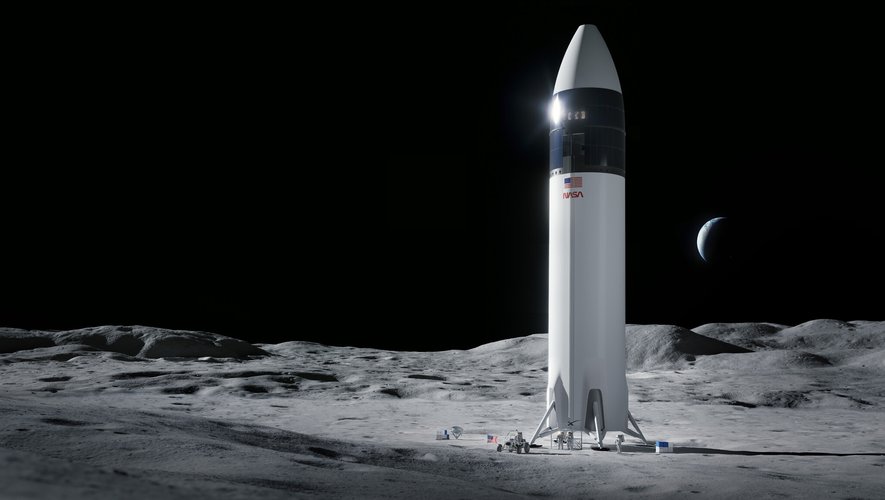the essentials Since December 14, 1972, no human being has set foot on lunar soil. An absence that should end in 2026 with the NASA-led Artemis 3 mission. But why is it so complicated to walk on the moon fifty years later?
“It's one small step for one man, one giant leap for humanity.” Neil Armstrong's words, spoken on the moon on July 20, 1969, still resonate 55 years later. This resonates even more since there is a large gap on Earth's natural satellite after the end of the Apollo missions. But things are about to change. Since the launch of the international Artemis program led by NASA in 2017, we have never been this close to walking on the moon. The latest news says it is scheduled for 2026. Why is this taking so long? For many reasons. First, the program is much more ambitious and complex than that of the late 1960s.
Target Mars
Artemis aims to establish a permanent presence on the Moon thanks to the orbit of a lunar space station called Gateway. This station will make it possible to travel back and forth to the Moon without having to return to Earth. Save time, money and fuel. Ultimately, it also offers the possibility of preparing the journey of the first crew to Mars in order to carry out the first manned exploration missions there.

The Gateway space lunar station will make it possible to travel back and forth to the Moon without having to return to Earth. NASA
Also read:
Man's return to the moon: the essential lunar gate, future station in orbit
For environmental and budgetary reasons, the Artemis program will also rely on reusable lunar landers. “The implementation of this architecture consisting of the Gateway station and reusable lunar landers is really complex,” explains Olivier Sanguy, head of space intelligence at the Cité de l'espace in Toulouse. “NASA is taking a risk in its decisions compared to China, which has a more traditional architecture and may be able to develop more quickly.” To carry out its lunar expeditions, NASA and its European, Canadian, Japanese and Emirati partners will rely on a range of spacecraft, not all of which have proven themselves yet.

Starship, SpaceX's lunar lander, is 50 m high. SpaceX
Also read:
Space: Thomas Pesquet hopes to be the first Frenchman to walk on the moon
Reusable lander, supply ship, Orion capsule
To carry out its first missions, NASA wants to use the Starship lander developed by SpaceX with a height of 50 m. The first two test flights last year failed for the time being. A third demonstration flight is planned for early 2024. Then the moon ship Starship must be refueled with fuel (fuel) in Earth orbit by replenishment ships. This risky operation has not yet been tested. Finally, the Orion capsule, powered by the SLS rocket (Space Launch System), still needs some adjustments.

The Orion capsule, manufactured by Lockheed Martin, can accommodate four astronauts. Lockheed Martin
This capsule, which will transport the four astronauts to the moon ship Starship, was tested in 2022. Their heat shield was changed in unexpected ways upon return to Earth's atmosphere. The Artemis 3 mission was therefore postponed from the end of 2025 to September 2026. “Safety is our priority,” NASA chief Bill Nelson said in early January. On the equipment side, Axiom Space is developing spacesuits adapted to the lunar environment. They are said to be reusable despite the abrasive moon dust. This was not the case before. Given all of these elements, there is still a lot of work to be done before we can almost safely return to the Moon.
Improved security
Safety is actually the other issue delaying man's return to the moon. “During the Apollo program, it was extremely difficult to fly to the Moon, and it is always complicated to carry out manned flights on the Moon,” explains Olivier Sanguy, because the basic technology has remained the same. “We've made advances in data processing, but it's still the case. With the rockets we're using, we're still landing on the moon with retro-propulsion… so it's difficult.”

NASA's SLS rocket on its launch pad. At the top, Lockheed Martin's Orion capsule will be used to transport the four astronauts. NASA – Kim Shiflett
And then the “accepted risks” for such a mission have evolved compared to the Apollo program. “For Apollo 11, the classic saying was that it was a one in two chance (of returning). For the moon landing, Richard Nixon had also prepared a speech in the event of the death of the crew. We didn't do that for Artemis. I don't really know. The only information we have concerns the Crew Dragon and Starliner capsules. NASA has required its service providers to limit the risk to one serious accident every 320 flights. “We remain within very high risk rates. higher than in aviation. But even with the Apollo missions we are not within the limits of what we could accept.”
Budget decreased
Finally, in addition to the political will, which of course plays a role in returning to the moon more or less quickly, the financial aspect is also a decisive factor. When NASA conducted the Apollo mission, it had more than 4% of the US federal budget. Today the situation has changed significantly. “The agency currently receives only 0.5% of the federal budget and manages the Artemis program, but also the ISS, Earth observation, robots on Mars, exploration probes, the Hubble Space Telescope, etc.”
Also read:
Fifty years ago they set foot on the moon
With fewer resources, more security and a strong commitment to the environment, it is not unusual for the return to lunar soil to take some time. Especially since the idea behind the Artemis program this time is not to set foot on the moon again, but to settle there. A project… moon, literally and figuratively.

